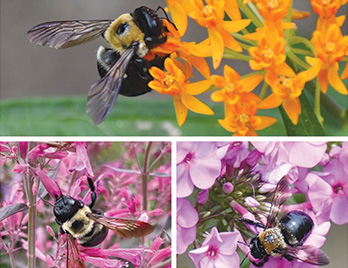Back when the kids were still living under our roof, for much of the spring we would have a bumblebee that would fly back and forth in front of our house close to the windows. We were all enthralled. I called her my pet and soon nicknamed her Babbity Bumble in reference to the bee in Beatrix Potter’s Tale of Mrs. Tittlemouse. These were stories I knew well from my childhood and had subjected my own children to many readings of the same little classic books taking place in the hedgerows in England. As a kid, my own mother had read Mrs. Tittlemouse to us, and I remember being quite frightened of the large bumblebee character that had taken up residence in Mrs. Tittlemouse’s underground passageways. The message of tidiness and insect pests was crafted by Potter who observed nature firsthand and supplemented that with regular visits to the Victoria and Albert Museum and their collection of insects in art which made a lasting impression. Since it’s pretty clear that I won’t be heading to the Motherland anytime soon, I googled the Victoria and Albert Museum to check out the collection that may have inspired Potter. Down the rabbit hole I went, and Potter would not have been pleased that I let the dust pile up around our hovel while I perused page after page of cool artifacts pertaining to insects.
Even though the bumblebee was villainized in Potter’s classic, she is anything but. The bumblebee is a native pollinator who is instrumental in the success of wildflowers and agricultural crops. According to the Xerces Society there are over 255 kinds of bumblebees, and they employ the technique of buzz pollination, vibrating plants to dislodge their pollen. The bees carry the pollen on their rear legs in a concave area known as the pollen basket. Being on the large and furry side, they are able to fly in cooler temperatures, becoming active in the early spring and visiting flowers through late fall. Unlike honeybees, the bumblebees do not make much extra honey as they do not overwinter as a colony. Their life cycle is mostly complete in one season, so planning for the dead of winter is not on their radar.
In the ultimate demonstration of self-sufficiency, the queen bumblebee as the sole survivor over the winter, will emerge and locate a cavity or a hole in the ground to start a new nest. She begins to collect pollen and creates wax pots to hold excess pollen and nectar. In these bee-crafted pots she will lay her eggs. In about a month these first eggs will have turned into larvae and emerged as adults, visiting flowers and collecting pollen. Once the queen has raised her first brood, she wises up and delegates raising future generations and hive maintenance to her first-born progeny. She can now spend all her energy on egg production. That’s a good thing since her colony can contain 50 or more individual bumblebees.
Around this time of year as summer days are trending down, I no longer pick up my hoe with much gusto. But, my resident bumblebees are still hard at work pollinating, showing no sign of slowing down. And here we sit, enjoying the fruits of their labor. I am channeling a friend who lives far away playing “Our House” by CSN and bringing a bouquet of State Fair zinnias to our table. I’m also thinking of my dad as I cut into a beefsteak tomato for the last BLT of the season. Music and flowers and food and children’s books and so much more help connect us to the past and to people we have loved. And the bumblebee once again held up her end of the bargain. So next spring when Babbitty Bumble is buzzing around checking out our digs for her perspective new home, you can bet that we will be trying our darndest to make every hole in the ground or cavity in our clapboards look appealing.
